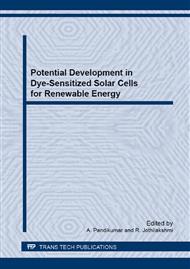[1]
A. Fujishima, T. N. Rao, D. A. Tryk, Titanium dioxide photocatalysis, J. Photochem.Photobiol. C. Photochem. Rev. 1 (2000) 1–21.
Google Scholar
[2]
M. Gratzel, Photoelectrochemical cells, Nature. 414 (2001) 338-344.
Google Scholar
[3]
O.K. Varghese, D. Gong, M. Paulose, K. G. Ong, C. A. Grimes, Hydrogen sensing using titania nanotubes,Sens. Actuators B. 93 (2003) 338–344.
DOI: 10.1016/s0925-4005(03)00222-3
Google Scholar
[4]
A. Hagfeldt, G. Boschloo, L. Sun, L. Kloo, H. Pettersson,Dye-sensitized solar cell, Chem. Rev. 110 (2010) 6595–6663.
DOI: 10.1021/cr900356p
Google Scholar
[5]
B.O. Regan, M. Gratzel, A low-cost, high-efficiency solar cell based on dye-sensitized colloidal TiO2 films, Nature. 353 (1991) 737- 740.
DOI: 10.1038/353737a0
Google Scholar
[6]
A. Yella, H. Lee, H. N. Tsao, C. Yi, A. K. Chandiran , M. K. Nazeeruddin, E. W. Diau, C. Yeh, S. M Zakeeruddin, M. Grätzel, Porphyrin-sensitized solar cells with Cobalt (ii/iii)–based redox electrolyte exceed 12 percent efficiency, Science, 334 (2011) 629-634.
DOI: 10.1126/science.1209688
Google Scholar
[7]
R. Jose, V.Thavasi, S. Ramakrishna. Metal oxides for dye sensitized solar cells, J. Am. Ceram. Soc. 92, 2 (2009) 289–301.
DOI: 10.1111/j.1551-2916.2008.02870.x
Google Scholar
[8]
N.-G. Park, J. van de Lagemaat, A. J. Frank, Comparison of dye sensitized rutile and anatase-based TiO2solar cells, J. Phys. Chem. B.104 (2000) 8989-8994.
DOI: 10.1021/jp994365l
Google Scholar
[9]
P.Roy, S. Berger, P. Schmuki, TiO2nanotubes: Synthesis and applications. Angew. Chem. Int. Ed. 50 (2011) 2904-2939.
DOI: 10.1002/anie.201001374
Google Scholar
[10]
D. V. Bavykin, V. N. Parmon, A. A. Lapkin, F. C. Walsh, The effect of hydrothermal conditions on the mesoporousstructure of TiO2 nanotubes. J. Mater. Chem.14 (2004) 3370-3377.
DOI: 10.1039/b406378c
Google Scholar
[11]
T. Kasuga, M. Hiramatsu, A. Hoson, T. Sekino, K. Niihara, Formation of Titanium Oxide nanotube. Langmuir, 14 (1998) 3160-3163.
DOI: 10.1021/la9713816
Google Scholar
[12]
M. S. Sander, M. J. Cote, W. Gu, B. M. Kile, C.P. Tripp, Template–assisted fabrication of dense, aligned arrays of titania nanotubes with well controlled dimensions on substrates. Adv. Mater. 16 (2004) 2052-2057.
DOI: 10.1002/adma.200400446
Google Scholar
[13]
D.Gong, C. A.Grimes, O. K.Varghese, W.Hu, R. S.Singh, Z.Chen, E. C.Dickey, Titanium oxide nanotube arrays prepared by anodic oxidation. J. Mater. Res. 16 (2001) 3331–3334.
DOI: 10.1557/jmr.2001.0457
Google Scholar
[14]
M. Paulose, K. Shankar, O. K. Varghese, G. K Mor, B. Hardin and C. A Grimes, Backside illuminated dyesensitized solar cells based on titania nanotube array electrodes, Nanotechnology 17 (2006) 1446–1448.
DOI: 10.1088/0957-4484/17/5/046
Google Scholar
[15]
D. Kim, A. Ghicov, P. Schmuki, TiO2 Nanotube arrays: Elimination of disordered top layers (''nanograss") for improved photoconversion efficiency in dye-sensitized solar cells, Electrochem. Commun.10 (2008) 1835–1838.
DOI: 10.1016/j.elecom.2008.09.029
Google Scholar
[16]
C. A. Grimes, G. K. Mor, TiO2 nanotube arrays synthesis, properties, and applications, Springer,2009.
Google Scholar
[17]
J. H. Lim, J. Choi, Titanium Oxide nanowires originating from anodically grown nanotubes: the Bamboo splitting model, Small. 3 (2007) 1504 –1507.
DOI: 10.1002/smll.200700114
Google Scholar
[18]
Z. Sun, J. H. Kim, T. Liao, Y. Zhao, F. Bijarbooneh, V. Malgras, S. X. Dou, Continually adjustable oriented 1DTiO2 nanostructure arrays with controlled growth of morphology and their application in dyesensitized solar cells. CrysEngComm. 14 (2012) 5472–5478.
DOI: 10.1039/c2ce00014h
Google Scholar



